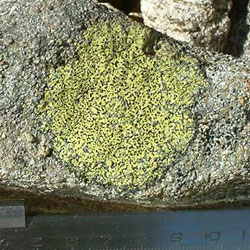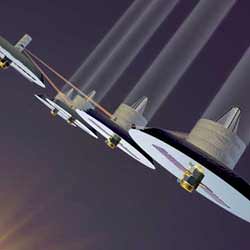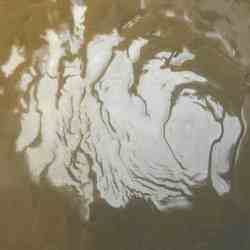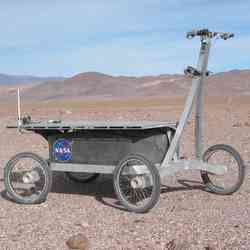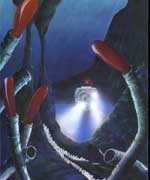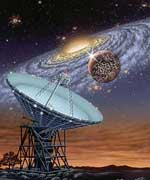
Image Credit: “Seeking” ?1998
Lynette Cook. Used with Permission.
“All truth passes through three stages. First, it is ridiculed. Second, it is violently opposed. Third, it is accepted as being self-evident.”
– German philosopher Arthur Schopenhauer (1788 – 1860)
Are we alone? Given the immensity of the Cosmos, a mathematical impossibility. Will we ever come to know we are not alone? That’s a tougher question. But should first contact occur today we could be in for a shock1. So right now may be a good time to prepare. And perhaps the best way to prepare is to imagine the possibility…
Numerous psychological studies have shown that “imagining a thing” makes us more receptive to the possibility. In fact many of the great breakthroughs in scientific thought came about as a result of the proper use of the creative imagination. Sir Isaac Newton saw the motions of all moons and planets everywhere in the simple fall of a ripe apple from the boughs of a tree. Albert Einstein perceived the relativity of all time and space while contemplating the accelerated motion of a trolley car moving away from the face of a public clocktower. We human beings might want to take a few moments and think about how we will respond should ET make an appearence in our small corner of the cosmos.
So, take a moment and relax. (Yes it’s true, deep breathing does help!) Imagine a universe populated with many and diverse forms of intelligent life. Extend yourself through time and space toward distant systems of suns and planets. See simple organisms thrilling to the rhythms of light and matter working in harmony to develop ever more sophisticated life-forms. Follow the earliest interstellar craft as they move tirelessly from system to system toward some distant beckoning beacon of promise. Surf beams of radiant energy flung like arrows from far away lighthouses upon the Ocean of Space.
Someday such imaginings may be confirmed by rock solid science – perhaps SETI will detect an indisputable signal from beyond, or “Michael Rennie” emerges as an emissary from the Galactic Federation of Planetary Systems trailed by Gort – the Wonder Robot.
Given the likelihood that such space-faring or highly communicative intelligences exist, and given all the billions of years for off-world intelligence to develop the means to travel and communicate, plus our own recent efforts to find them out, why don’t we know already?
One, and possibly the very best answer is “We aren’t ready.”
The human imagination also has its down-side: Imagine the initial shock and ridicule as we humans attempt to upright a world overturned by what for many will be an impossible event. Consider also how governments and institutions, groups and individuals, have responded to similar reports in the past. Remember “Mars-rock”? Do we hear much of it now? And what about pilot Hap Arnold’s “flying saucer” report. Can we really say that we have taken clear-headed, scientific looks at such things? Or is our normal response one of incredulity and ridicule? Hmmmm…
To know is to see truth wherever it may be found. No, we’re not saying that UFO’s have visited the Earth. What we are saying is that our response to those who make such claims is often one of ridicule and disrespect. Is it not possible that compassion and open-mindedness would be more appropriate?
So let’s seek truth where it can be found – right here on Earth. We can start by looking for unsuspected signs of intelligence around us2. Let’s take a clear-eyed look at our animal friends by setting aside prejudices concerning their intelligence. Those goldfish in the aquarium can be surprisingly sensitive about things. Walk near the tank during the day and they ignore you. Come feeding time, and you are the most interesting thing in the world to them.
To be sure we are very unlikely to learn that the universe is suffused with intelligence until we get past our own anthrocentrism. It took a lot of hard work (and self-sacrifice) by Copernicus, Kepler, and Galileo just to get western society to finally step “up to the edge” and see that the Blue Planet is most definitely not flat nor does it act as the axis around which all things celestial swing.
And even with the signs of intelligence abounding on our homeworld today we persist in thinking that all creatures exist for us, our amusement, our purposes. Under such conditions can we possibly appreciate how truly intelligent they are? And to be more germane, do we really think ET might want to come out and play with us under such circumstances?
Today we don’t seem to be ready to accept anything other than the myth of being alone. Yes, one way to tell this does have to do with how we relate to other creatures on the Blue Planet, but there are other reasons to doubt our readiness as well. Consider our political institutions; Why is it that our leaders and their associates spend so much time “down-playing” the truth of things, presenting specious arguments to motivate behavior, or putting controversial issues into the spin cycle? Is it because of hidden political or economic agendas? Or possibly because they don’t believe we can handle reality3?
Meanwhile high overhead, ET approaches the Earth – third stone from the Sun – and initiates a scan of the EM spectrum. Newscasts portray crisis after crisis, violence, conflict, bloodshed, environmental degradation. How would you – an intelligent being from elsewhere respond?
Personally, I’d activate the cloaking device.
ET is no dummy – he/she/it is after all an intelligent life-form possessed of advanced technology. One scan of Earth’s broadcast media and ET soon comes to see that this is not a place to be trifled with: The natives are restless. Emotion overrules reason. Reaction upstages proaction. Nations practice deception and ill-will in relationships – internal and external. Angry voices shout each other down – not just on the streets but in the houses of governance as well. We are not a happy bunch.
And yet the future remains always a bright star of possibility. Hope springs eternal in ET’s breast (or left antibular thorax as the case may be…)
ET of course, has seen such things before. Countless worlds of lesser and greater advancement have been encountered. Before ET learned the wisdom of keeping a safe distance, he-she-it actually tried to help a few troubled worlds such as our own. In the end ET may have had to overcome shock, ignorance, even bloody insurgencies. Costs were great, rewards few. Now ET waits – waits for us to pass certain tests – tests defined in some intragalactic protocol: “The Prime Directive”.
So the hailing frequencies are locked down. ET goes stealth. “Subspace” signals are transmitted to ET Central: “Earthlings are still at it. Planet approaching ecological crisis. Species dying off. The few have much, many have little. Schedule re-visit next solar maximum. Report over and out.”
Today our instruments can peer back to the very threshold of the Big Bang – nearly 13.7 million lightyears distant in time and space, millions and millions of galaxies, billions and billions of Suns. Who knows how many planets – many equal to or superior to our own in fecundity and arability. Some populated as yet only by single-cell organisms. Others by beings possessed of no organic form whatsoever. It doesn’t even take the imagination to see the possibility anymore. Those of us interested in astronomy also read and watch science fiction. All the heavy lifting has been done for us. Fantastic lifeforms dwell in fabulous environs undergoing incredible adventures: Star Trek, Star Wars, Babylon Five – you name it – we’ve seen it. And yes, many of us believe in our hearts – but even so, we want to know.
Even now we scan the heavens seeking proof. The SETI project is bringing its array of parallel narrow-band scanning recievers on line. We hope against hope that some not-too-circumspect intelligence is out there broadcasting narrowband signals intentionally (or not) seeking to conclusively demonstrate their presence in our universe.
Will SETI find them out? And if so, how will we respond to the reality?
It is possible to uncover intelligence in this way, but intelligent life-forms not only learn from experience but in advance of experience as well. Do we here on Earth choose to project our presence intentionally into the interstellar medium4?
No – that particular notion has already been discarded and perhaps wisely so. We know what we are like – others could be worse!
Psychology plays a big role in choices made by intelligent creatures. When they don’t trust others, they “down-play” the truth or offer specious arguments. When they make mistakes, they put things in the “spin cycle”. When they see other intelligences doing these kinds of things with great regularity they know that contact is to be avoided. Perhaps this is at essence in first contact protocol. Until truth is welcomed – even at the expense of notions held dear – a world is not ready. Otherwise the cost of engagement is too high, benefits too low, and outcomes too unpredictable – or worse – dangerous.
But we may detect extraterrestial intelligence in other ways. It’s a solid assumption that all advancing technologies pass through a broadband em broadcast phase. During such an era civilizations “leak” evidence of their existence. Unfortunately, even our largest radio telescope would be hard pressed to detect broadband transmissions – such as Earth’s – from as close as the Alpha Centauri system. Meanwhile the window on em broadcast may even be closing here on earth. How many of us watch television programs delivered by antenna today? Less than a half-century ago every house had its own “rabbit ears”. One-hundred years from now we may be EM mute…
We might also intercept a signal in transit between two worlds. Such an event would be serendipitous – luck would play a huge role. First we would have to be more or less line of sight. Why? Because the tighter such a signal is foused the further it travels without attenuation. Although laser (and maser) transmissions do diffract over great distances, we would still need to be well-placed to pick one up. Meanwhile such signals may not necessarily be narrow band in frequency. Why? Because phase-modulated transmission may be the most efficient way to transmit pictures, sounds, and data across space5.
Despite all these barriers to revelation what practical steps can we now take to prepare for some future “first contact”?
Assisted by writers of science fiction and purveyors of motion pictures, we’ve already made a start by imagining the possibility. Animal behaviorists have helped prepare us by investigating various types and degrees of intelligence in the natural world. Psychologists and socioligists have done the same thing in the realms of our own species.
Meanwhile on an individual basis we can all learn to pay more attention to intelligence as seen within our families, among friends, associates – and even strangers. (Perhaps especially strangers.) All this makes us more aware of what intelligence is and how it is communicated.
On the broadest possible levels we must all further our ability to welcome and speak truth – despite any pain it may leave in its wake.
Having done our own personal work, “homeworld work” can go forward. Collectively we can work together to expunge the seeds and uproot the weeds of war on the planet. Although this means holstering our weapons, it also means overcoming a persistent propensity toward propaganda, religious strife, scientific contention, and undue corporate economic advantage.
And of great importance at this time is the need to be more supportive of other homeworld species – irrespective of intelligence. Ecology teaches us that every creature plays an important role in Earth’s biosphere. Perhaps it should become a matter of human education, demographical planning, economics, and political activity to ensure that this particular insight truly guides our choices and behavior. After all so long as we remain exploitative of lesser species no truly intelligent extraterrerestial species is likely to have much to do with us. Scarier still, if there are any “bad boys” out there, they could easily rationalize “taking over the joint”.
So let’s say we clean up our act. What happens next?
Isn’t that enough? To live in a world where truth multiplies, nature is respected, intelligence is recognized, and peace reigns supreme is actually quite appealing in itself – for most intelligences worthy of interstellar relations.
But this article is not about social transformation per se – it’s about the very real possibility of first contact – something that could transpire even before our children take a leading role in the unfolding story of human history.
Are we ready to get ready?
If intelligence can germinate here, it can flower elsewhere. Why, of course, it’s all so – “self-evident!”
1 The 1997 hit movie “Contact” (based on a novel by Carl Sagan) portrayed the many and varied ways in which human beings responded to scientific proof of the existence of advanced extraterrestrial intelligence.
2 According to a BBC News article a captive African grey parrot named N’kisi has a vocabulary of almost one thousand words, shows evidence of a sense of humour, and devises new words and concocts phrases as needed.
3 Irrespective of its overall merits, US efforts to topple an Iraqi dictatorship were found to be based on overstated evidence. (See Conclusions of Senate’s Iraq report) Such misuses of information often occur when a government is unable to speak plainly to its citizens concerning matters of importance.
4 In an article published by the title Quantum Communication Between the Stars? SETI Institute member Seth Shostak recalls the heated response of England’s Astronomer Royal to the ad hoc messaging of M13 during a 1974 ceremonial at the Arecibo radio telescope in Puerto Rico.
5 The narrower the frequency used to transmit data through space the higher the signal-to-noise ratio. The most efficient mode of such transmission is to digitally switch a carrier frequency “on and off”. Such serial modes of transmission however, are very slow at transfering large amounts of data through space in short amounts of time. Such signals are however very useful for saying things like “look at me I am here!”.
About The Author: Inspired by the early 1900’s masterpiece: “The Sky Through Three, Four, and Five Inch Telescopes”, Jeff Barbour got a start in astronomy and space science at the age of seven. Currently Jeff devotes much of his time observing the heavens and maintaining the website Astro.Geekjoy.
